American Bank Note Company print runs for El Banco de Londres y México
The American Bank Note Company produced the following notes after the bank changed its name to the Banco de Londres y México in 1889. It produced a special vignette of Benito Juárez (C155).
The proof for the $5 note with printed date 1 July 1889 and signatures of Jones and Waters was approved on 12 June 1889CNBanxico #6754.
| Date | Value | Number | Series | from | to |
| September 1889 | $5 | 35,000 | A | 1 | 35000 |
| $10 | 37,500 | A | 1 | 37500 | |
| $20 | 35,000 | A | 1 | 35000 | |
| $50 | 25,000 | A | 1 | 25000 | |
| $100 | 21,000 | A | 1 | 21000 | |
| $500 | 4,000 | A | 1 | 4,000 | |
| $1,000 | 2,000 | A | 1 | 2000 |
| Date | Value | Number | Series | from | to |
| April 1891 | $5 | 40,000 | A | 35001 | 75000 |
| $10 | 20,000 | A | 37501 | 57500 | |
| $20 | 10,000 | A | 35001 | 45000 | |
| $50 | 3,000 | A | 25001 | 28000 | |
| $100 | 2,500 | A | 21001 | 23500 |
| Date | Value | Number | Series | from | to |
| July 1892 | $5 | 40,000 | A | 75001 | 115000 |
| $10 | 30,000 | A | 57501 | 87500 | |
| $20 | 10,000 | A | 45001 | 55000 | |
| $50 | 6,000 | A | 28001 | 34000 |
Over the years the ABNC altered the plates by changing the date line and engraving various signatures.
In February 1893 it was reported that someone had asked the American Bank Note Company to produce plates for notes for the Banco de Londres y México, giving a PO box for the reply. The ABNC told the governor of the Federal District, José Ceballos, and the police picked up the hapless villain when he went to collect the replyLa Voz de Guanajuato, 5 February 1893.
| Date | Value | Number | Series | from | to |
| December 1895 | $5 | 45,000 | A | 115001 | 160000 |
| $10 | 32,500 | A | 87501 | 120000 | |
| $20 | 20,000 | A | 55001 | 75000 | |
| $50 | 10,000 | A | 34001 | 44000 | |
| $100 | 6,500 | A | 23501 | 30000 | |
| $500 | 1,000 | A | 4001 | 5000 | |
| $1,000 | 600 | A | 2001 | 2600 |
| Date | Value | Number | Series | from | to |
| February 1897 | $5 | 160,000 | 1 | 160000 | |
| $10 | 120,000 | 1 | 120000 | ||
| $20 | 75,000 | 1 | 75000 | ||
| $50 | 40,000 | 1 | 40000 | ||
| $100 | 30,000 | 1 | 30000 | ||
| $500 | 2,500 | 1 | 2500 | ||
| $1,000 | 1,250 | 1 | 1250 |
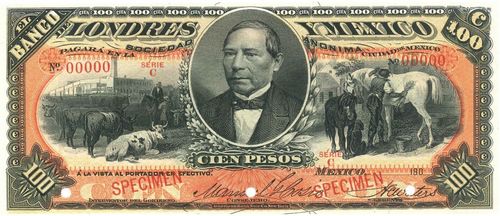
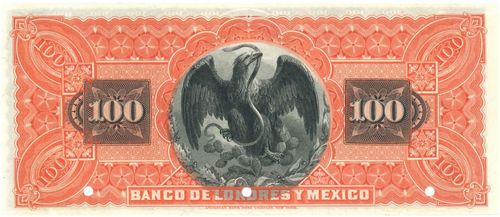 M275s $100 Banco de Londres y México specimen
M275s $100 Banco de Londres y México specimen
| Date | Value | Number | Series | from | to |
| February 1900 | $5 | 100,000 | 160001 | 260000 | |
| $10 | 100,000 | 120001 | 220000 | ||
| $20 | 75,000 | 75001 | 150000 | ||
| $50 | 40,000 | 40001 | 80000 | ||
| $100 | 30,000 | 30001 | 60000 | ||
| $500 | 2,000 | 2501 | 4500 | ||
| $1,000 | 1,000 | 1251 | 2250 |
| Date | Value | Number | Series | from | to |
| December 1905 | $5 | 300,000 | 260001 | 560000 | |
| $10 | 50,000 | 220001 | 270000 |
On 27 January 1909 the bank ordered 200,000 $5 and 100,000 $10 notes, all series E, and sent facsimile signatures of W. B. Mitchell as Gerente and G. Höpfner as Sub-gerente. They also specified F. Cortina as the Interventor and José Sánchez Ramos as Consejero on the $5 and L. Signoret on the $10 noteABNC, folder 288, Banco de Londres y México (1909-1915). On 21 May they were asked for a copy of Cortina’s signature, but the next day was told not to print the signature. The ABNC had promised half of the delivery by 26 May but, because of this hold-up, delivery was delayed until 10 June, when they sent, by U. S. Express, a box containing 20,000 $5 (E 560001-580000). The Resident Agent, H. Leslie Hendriks, wrote “You must certainly realise that it is very hard for me to keep our customers in a pleasant frame of mind under such conditions. Of course, almost invariably (in fact entirely so in the past ten years) you deliver in accordance with your promise, but here is a case where it requires a good deal of tact and ingenuity on my part to keep things running smoothly with my customer.” On 18 June the ABNC explained “After looking into the matter, we found that an error was made on the plate, and it was necessary - after the printing of the notes was done, to type in the name of the Sub-Gerente, which had been overlooked in the engraving: this has caused a great deal of spoilage and delay in the printing, and in keeping our promise which we extremely regret.”
| Date | Value | Number | Series | from | to |
| February 1909 | $5 | 200,000 | E | 560001 | 760000 |
| $10 | 100,000 | E | 270001 | 370000 |
On 24 June 1909 the ABNC sent, by U. S. Express, 40,000 $5 (580001-620000) and 40,000 $10 (270001-310000). On 7 July 1909 they completed the order by sending 140,000 $5 (620001-670000) and 60,000 $10 (310001-370000).
On 13 August 1909 Hendriks reported that “The managers of the bank are complaining with regard to the trimming of most of their $5.00 notes. There is a wide margin at the top and no margin whatever at the bottom. They got quite unpleasant about it. They are not pleasant at the best of times and I have all I can do to keep things running smoothly with them and this order, what with delayed delivery and now this bad trimming of notes, has been anything but easy. They seem to be always looking for something to pick on. However, I think I have smoothed them out for the time being, but please rush this other order [for $500 and $1,000 notes] so I can get through without any further complaints if such a thing is possible. You might also write me as to how these $5.00 notes came to be trimmed as badly, as I told them I would write you about it.” The ABNC’s factory explained “To give you full details, would say that these notes were fully printed four on, and it was possible to trim them with perfect safety. About a year ago we made-up a new set of plates eight on, allowing the same margins but owing to the size of the sheet, it was practically impossible to trim them absolutely true, which is the cause for their complaint. The request has been taken up, and new plates will be made allowing a larger margin, which will prevent any trouble of this kind occurring in the future.”
Even before they received all these $5 and $10 notes, the bank, on 18 June 1909, had ordered 3,000 $500 and 1,000 $1,000 notes, both Series E. The ABNC thought that, according to their records, these should be Series C, but on 13 August the bank confirmed it wanted Series E.
| Date | Value | Number | Series | from | to |
| June 1909 | $500 | 3,000 | E | 4501 | 75000 |
| $1,000 | 1,000 | E | 2251 | 3250 |
On 24 August 1909 the ABNC shipped, by U. S. Express, 3,000 $500 (E 4501-7500) and 1,000 $1,000 (E 2251-3250).
On 30 March the bank ordered 10,000 $100 notes, all Series D, with W.B. Mitchell as Gerente and H. Tron to replace Manuel González Cosío as Consejero.
| Date | Value | Number | Series | from | to |
| April 1910 | $100 | 10,000 | D | 60001 | 70000 |
On 27 June 1910 the ABNC sent, by Wells Fargo Express, a box containing the 10,000 $100 (D 60001-70000). Again the bank had a complaint, asking that “the signatures appearing on bank notes be brought out a little bit stronger than these on the $100 notes which you have just sent them.”
On 30 May the bank ordered another $2,500,000 in notes of four denominations, with two series letters. They instructed that Andrés Bermejillo should replace Ignacio de la Torre on the $50 notes, and that ”On all notes wherever the signature of G. Hopfner appears as Sub-Gerente this is to be changed to W. B. Mitchell as Gerente and wherever the signature of W. B. Mitchell has appeared as Sub-Gerente is to be changed to Gerente.”
| Date | Value | Number | Series | from | to |
| June 1910 | $5 | 100,000 | E | 760001 | 860000 |
| $10 | 50,000 | E | 370001 | 420000 | |
| $20 | 25,000 | D | 150001 | 175000 | |
| $50 | 20,000 | D | 80000 | 100000 |
Again these took some time, as on 30 August the ABNC explained “The time of delivery of these notes may seem to you rather slow, but as the bank changed the signatures which were in the plates, it made a very bad alteration, as these signatures ran through pantograph work, which makes a most serious alteration.” So on 20 September the company forwarded, by Wells Fargo Express, two boxes containing 4,000 $5 (E 760001-764000), 50,000 $10 (E 370001-420000, 15,000 $20 (D 150001-165000) and 10,000 $50 (D 80001-90000). It completed the order on 30 September by shipping 76,000 $5 (E 764001-840000), 12,000 $20 (D 163001-175000) and 10,000 $50 (D 90001-100000).
On 30 March 1911 Hendriks enclosed an order for 2,000 $500 and 1,000 $1000 notes, asking “Please print these notes on 27 lbs. Planchette paper as the bank has been complaining about the light weight of paper used in the past.” The ABNC replied “Your request that we use planchette paper, we cannot comply with, as all Planchette paper is especially laid out for the notes that we are to print and in this case it would be impossible to ask Crane & Co. to make us paper for such a small quantity. You may think that we could use something from stock, but this would be taking a great chance, and we think it best not to try this, but we will use our regular J. M. 27 Bank Note paper on this order, which they probably will find more satisfactory than the lighter weight.”
| Date | Value | Number | Series | from | to |
| April 1911 | $500 | 2,000 | F | 7501 | 9500 |
| $1,000 | 1,000 | F | 3251 | 4351 |
These notes were sent, by Wells Fargo Express, via Laredo, on 29 April.
On 17 July 1911 the bank ordered another $3,000,000 in five denominations and two series. The signatures on the notes were to remain the same as the last issue with the exception of those on the $20 and $100 notes, for which the new signatures of Remigio Noriega and José Spitalier as Consejero were sent on 21 July.
| Date | Value | Number | Series | from | to |
| July 1911 | $5 | 100,000 | 860001 | 960000 | |
| $10 | 50,000 | 420001 | 470000 | ||
| $20 | 25,000 | 175001 | 200000 | ||
| $50 | 10,000 | 100000 | 110000 | ||
| $100 | 10,000 | 70001 | 80000 |
On 13 December the ABNC completed the order by forwarding all these notes, by Wells Fargo Express, via Laredo.
On 23 January 1913 Blackmore, the Resident Agent, forwarded another order, writing “The note to be dated January 2nd 1913. The signatures to be the same as last order. Kindly proceed first with the $100.00 notes and ship same when ready; filling the balance of the order as soon as possible as the bank is in urgent need of these notes.
When the Manager, Mr. W. B. Mitchell was giving me the order he complained against the paper and asked why you did not use the same class of paper as furnished with the Canadian Notes. I told Mr. Mitchell the quality was the same, and that the notes here got harder usage. I take it that perspiration from the people here helps to destroy the notes, also the custom of the Express passing twine through envelopes containing notes damages the enclosures greatly. Do you consider tropical climate affects Notes at all?
Mr. Mitchell also complained against the price claiming he had had cheaper work offered of the same quality. I will endeavour to get the price he spoke of and if possible a sample of the work and will forward same to you.”
On 31 January New York replied “With reference to this date we would say that although a number of years ago a date appeared on the plate, the last few orders have been executed with the date line left blank – to be filled in by the Bank. However, we are inserting the date this time as instructed and all notes will read as follows:- “Mexico, 2o de Enero de 1913”. This date will be typed, which you will understand, means an additional printing operation.
You say that the Manager – Mr. W. B. Mitchell is complaining as to the price; you might point out to him that we are furnishing this order at the same rate as heretofore, although, as stated above, we have an additional printing operation. This is in reality a considerable reduction inasmuch as the typing of the date on notes is a very slow operation and great care has to be taken to obtain a good registry.
With regard to the paper, we have had some previous correspondence about the quality of the same. We only have one kind of bank note paper, which we use for all notes, and we have used the same paper for their notes for the Canadian notes referred to by Mr. Mitchell. However, the paper used for the Canadian notes is slightly heavier, and we are therefore using the same weight paper in this present order, and feel sure that it should give no cause for complaint. Of course, tropical climates do effect paper considerably, but all bank note paper is manufactured especially to withstand these climatic conditions, and has the greatest strength and durability obtainable, - at the same time being of a thinner quality than the European paper.”
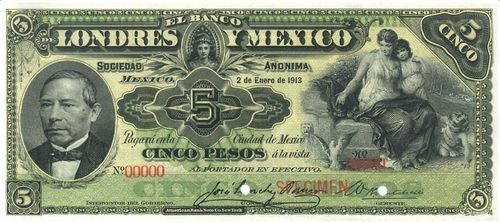
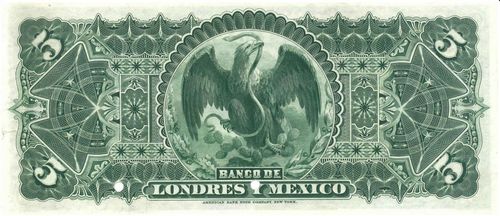 M271s $5 Banco de Londres y México specimen
M271s $5 Banco de Londres y México specimen
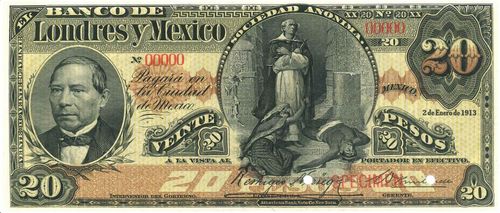
 M273s $20 Banco de Londres y México specimen
M273s $20 Banco de Londres y México specimen
| Date | Value | Number | Series | from | to |
| January 1913 | $5 | 100,000 | G | 960001 | 1060000 |
| $10 | 50,000 | G | 470001 | 520000 | |
| $20 | 25,000 | F | 200001 | 225000 | |
| $50 | 10,000 | F | 110000 | 120000 | |
| $100 | 10,000 | F | 80001 | 90000 |
By the end of April the bank was desperate for these notes and asked the ABNC to ship them via Veracruz. The ABNC was already preparing to ship the notes when Blackmore’s telegram arrived, and since they were unable to get goods delivered over the border by express, had decided to send them via Veracruz in charge of Wells Fargo & Co. Express, a new express route just established by that company. On 30 April they sent two boxes containing 70,000 $5 (G 960001-1030000), 20,000 $10 (G 470001-490000) and 10,000 $100 (F 80001-90000), and on 10 May completed the order with 30,000 $5 (G 1030001-1060000), 30,000 $10 (G 490001-520000), 25,000 $20 (F 200001-225000) and 10,000 $50 (F 110001-120000).
On 2 September the bank asked for another $3,000,000 in notes, dated "1o de Octubre de 1913" and the signatures to be the same as on the January 1913 order.
| Date | Value | Number | Series | from | to |
| September 1913 | $5 | 100,000 | H | 1060001 | 1160000 |
| $10 | 50,000 | H | 520001 | 570000 | |
| $20 | 25,000 | G | 225001 | 250000 | |
| $50 | 10,000 | G | 120000 | 130000 | |
| $100 | 10,000 | G | 90001 | 100000 |
On 4 November Blackmore wired “Ship all you possibly can by next steamer bank notes. If already sailed ship through (via) Key West” and New York replied “have now ready 40,000 $5.-, 12,000 - $20.- 10,000 - $50. There is nothing saved by ship via Key West. Every inquiry is being made as regards New Orleans.” They then explained “we had our shipping agents ascertain which would be the quickest route to Veracruz. They informed us that although they were both leaving Key West for Havana there were very few boats between that city and Veracruz, and that we would be taking a risk in getting them through any quicker than by a direct route and at the same time would be sure to have trouble with the Cuban Customs officials.
From New Orleans we find that there was no boat leaving before November 18th therefore decided the quickest method of getting the notes to Veracruz was via Ward Line steamers leaving November 13th. … By that date we hope to have more notes ready than advised in our telegram of November 6th, and you can rely on our shipping all we possibly can.”
The company shipped the whole order on 12 November, by Wells Fargo Express, via Veracruz, per the S. S. “Esperanza”.
In December Mitchell, the manager, was still bleating on about the quality of paper, claiming that the paper the ABNC furnished for the Canadian notes was better than that furnished for the Mexican notes. New York told Blackmore “You may contradict Mr. Mitchell as flatly as the English language will allow. If he knew anything at all about paper, he would know better, the paper for both notes is identically the same, made in Crane’s Mills, and is as near alike as human ingenuity and the perfection of human machinery will permit it to be. We do not believe that there is an expert in the world who could tell them apart.
We have written to our Canadian Branch for samples of paper they use for Canadian notes, and will send some to you along with samples of paper we use for Mexican notes, and if Mr. Mitchell or any one else who claims to know anything about paper, will examine these samples - if he or they really have any knowledge of paper, they will see that they exactly the same.
It is not at all surprising that the Mexican notes will not wear as well as Canadian notes, and a person who really knew something about paper would understand this. The Mexican notes get a usage which is far rougher and heavier than the Canadian notes, The Mexican climate is a warm one, and in many parts of Mexico a damp one. The notes are frequently carried against the human body which in warm countries is apt to perspire freely, and this perspiration has material influence on the rotting of the paper. This is a well known fact to everyone who knows anything about paper.
These conditions do not apply with anything like as much force in Canada.
With regard to Waterlow's paper, other banks and countries have tried the experiment which Mr. Mitchell proposes to try, with disastrous results. They had a note furnished to them which was inferior in appearance, in protection and in the wearing quality of the paper.
We have written you very bluntly and strongly on this subject because we feel that Mr. Mitchell’s statements are something of an imputation upon us, and we do not like such aspersions.”
On 9 December 1913 the bank ordered $5,000,000 in notes. The signatures were to be the same as on the September order, with the exception of the $50 notes, where A. David’s signature would replace A. Bermejillo’s.
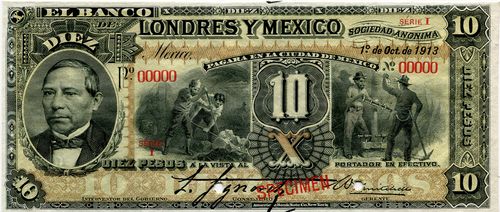
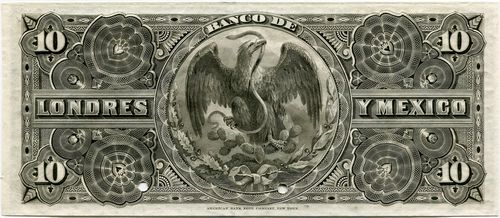 M272s $10 Banco de Londres y México specimen
M272s $10 Banco de Londres y México specimen
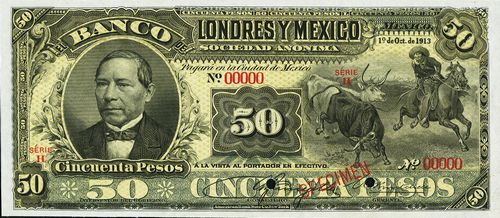
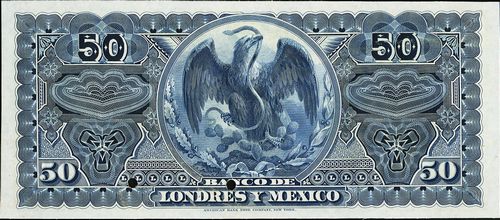 M274s $50 Banco de Londres y México specimen
M274s $50 Banco de Londres y México specimen
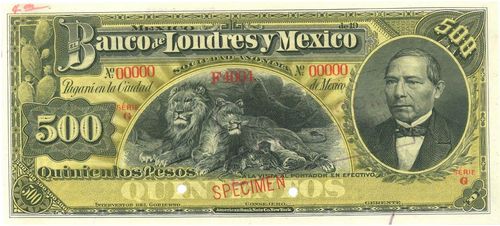
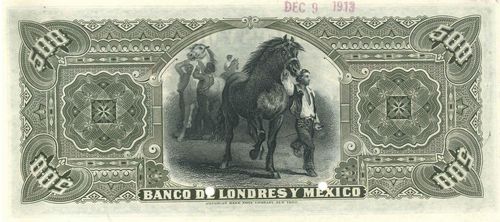 M276s $500 Banco de Londres y México specimen
M276s $500 Banco de Londres y México specimen
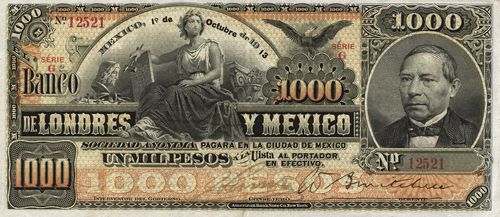
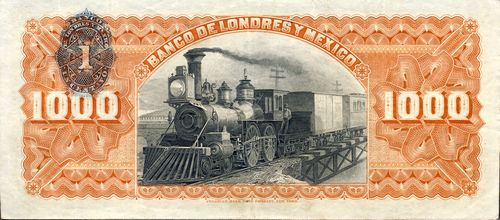 M277s $1,000 Banco de Londres y México specimen
M277s $1,000 Banco de Londres y México specimen
| Date | Value | Number | Series | from | to |
| December 1913 | $5 | 500,000 | I | 1160001 | 1660000 |
| $10 | 250,000 | I | 570001 | 820000 | |
| $20 | 75,000 | H | 250001 | 325000 | |
| $50 | 50,000 | H | 130000 | 180000 | |
| $100 | 40,000 | H | 100001 | 140000 | |
| $500 | 22.000 | G | 9501 | 31500 | |
| $1,000 | 11,000 | G | 4251 | 15250 |
On 17 December the ABNC sent specimens of the bank note paper used by their Ottawa Branch for the notes furnished to the various banks in Canada, duly certified by M,r Machado, Vice President of the Ottawa branch, and a copy of a letter from Mr. Machado, giving actual facts and statistics as to the difference in the wearing qualities between English bank note paper and Crane’s bank note paper, showing conclusively that Crane’s paper was far superior.
This time, the ABNC found they would have to prepare new $5 face plates. On 19 December the bank asked them to rush the $500 and $1,000 notes, but the next day the ABNC replied that the best it could do was $1,000 notes on 8 January and some $500 on 15 January. “We do not think you are aware that these notes of high denomination have five steel plate printings and also are printed only one on a plate. Of course we do not, these days, furnish notes of this kind. The original order from this bank was received over 20 years ago and it was our custom in those days, to print the colour work on 500 and 1000 peso notes, from steel plates instead of by lithography. Also at that time, on the small quantities of notes ordered we never prepared printing plates but printed from the original dies. This means that the notes of these denominations are not 4 or 6 or 8 on as in the case of the other values, but are only one on, and are printed on our single plate machines.
For instance, take the case of the 500 peso notes. 2,000 of these are called for, which, with five steel printings, one on, means 10,000 impressions. The greatest number of impressions that can be printed in a single day from our single plate presses is, at the most, 800. If we divide 800 into 10,000 you see the actual printing alone will occupy at the very least 12½ days and this does not make any allowance for the making ready of the press, the proving for each colour and the washing up after each printing. There is, on an order of this size, at least 2½ to 3 weeks actual printing work. To this has to be added the time necessary for repairing the engravings (which are very worn) and the time needed to count, examine, number and the general finishing. The same thing applies to the 1,000 Pesos notes.
We give this explanation at some length because we want you to understand that the delivery dates we give are very good under the special circumstances and we would be glad if you will try and explain our position to the bank.
We are rushing all the Mexico work as much as we can but in nearly every case, owing to the fact that these orders are so ancient, we're having the above mentioned difficulties to contend with and also are having to repair the engravings for nearly every denomination.
Here again, in the case of notes of high denominations, where we print, as we have told you, from the original dies, it is a very long business to repair the plates. You see, we cannot just lay down new plates but have to have an engraver work over those original dies and he cannot be hurried in a job of this kind,
We hope to have made our position clear and that this bank will realise that we are doing our very best.”
Despite all this, on 31 December the ABNC forwarded, by registered mail, a package containing 500 $1,000 (G 4251-4750).
On 15 January 1914 the ABNC forwarded, by Wells Fargo Express, per the steamer “Mexico”, a case containing 16,000 $10 (I 570001-586000), 16.000 $20 (H.250001-266000), 16.000 $50 (H 132001-148000), 2.000 $100 (H 100001-102000) and 1,000 $500 (G 10501-11500). On 22 January it forwarded, on the steamer “Monterey”, four boxes containing 100,000 $5 (I 1160001-1260000). 20,000 $10 (I 586001- 606000), 30.000 $20 (H 266001- 296000), 26,000 $50 (H 148001- 174000), 20,000 $100 (H 100001-120000) and 1,000 $500 (G 10501-11500). On 29 January it sent, via the steamer “Morro Castle”, fourteen boxes containing 400,000 $5 (I 1260001-166000), 214,000 $10 (I 606001-820000), 29,000 $20 (H 296001- 3250000, 6,000 $50 (H 174001-180000), 20,000 $100 (H 120001- 1400000), 20,000 $500 (G 11501- 31500) and 10,000 $1,000 (G 3251-15250).
On 2 December Blackmore reported that the bank had not yet decided whether to issue $1 and $2 notes. However, he had had a long talk with Mitchell, who flatly refused to give him the order in the event of their deciding to issue, as the bank could get cheaper prices and a far superior paper from Waterlow and Sons.
On 30 December Blackmore wired that the bank was considering a new order of 1,500,000 notes, including $1 and $2 notes, totalling $31,000,000500,000 $1, 250,000 $2, 400,000 $5, 200,000 $10, 50,000 $20, 40,000 $50, 30,000 $100. 5,000 $500 and 2,500 $1,000, with the same series letter as the last order and dated 1 October 1913. The bank was asking when the ABNC would be able to complete this order. “The Manager of the bank told me that to secure this order it would be necessary for you to deliver it complete together with the order of December 8th. within 60 days.”
On 12 January 1914 Blackmore wired that the bank had cancelled the order for $1 and $2 notes on account of the need for a quick delivery and had awarded the commission to another printer (Bouligny & Schmidt). New York responded the next day that typographic bank notes were very dangerous, because of the risks of counterfeiting, and asked if Blackmore could not arrange for the bank to replace the typographic $1 and $2 notes with the ABNC’s as soon as it made delivery. It had prepared the models (a face and two backs for the $1, and a face and back for the $2) and on the chances that they may be of use to Blackmore in securing the order had sent them by registered mail. Blackmore received the models on 26 January. He did not expect to receive an order for the present, but promised to keep after the business, in case Bouligny & Schmidt failed to furnish the bank with a good looking note.
However, on 3 February, when the bank confirmed its order it had reduced it to 300,000 $5, 150,000 $10, 75,000 $20, 30,000 $50 and 40,000 $100, to be dated 1 February 1914. A few days later, on 7 February, the bank’s manager, Mitchell, wrote to Blackmore, “we beg to say that we are in no hurry for the notes for a total value of $10,000,000.00 ordered in our letter of the 3rd. inst., and we should therefore be obliged by your giving instructions to your people, to hold the order in suspense until you hear from us further regarding same.”
| Date | Value | Number | Series | from | to |
| February 1914 | $5 | 300,000 | 1660001 | 1960000 | |
| $10 | 150,000 | 820001 | 970000 | ||
| $20 | 75,000 | 325001 | 400000 | ||
| $50 | 30,000 | 180000 | 210000 | ||
| $100 | 50,000 | 140001 | 190000 |
On 24 March Blackmore sent an example of Boluligny & Schmidt’s $2 note, The ABNC commented “This is certainly a very good example of what a bank note should not be. You do not tell us what the Banco de Londres thinks of these notes but we imagine that Mr. Mitchell has the same opinion of them as we have.
Perhaps in one way it is a good thing that these notes were ordered elsewhere as it certainly shows up the work of our competitors and we would not be surprised to hear from you that the bank has decided to place the order for these denominations with us - as was the case of the Banco Oriental.
You have the models we prepared and we suggest that you keep after this matter for us, especially if things begin to slacken a bit and the bank finds that they can wait until decent engravings are prepared.”
On 21 May 1914 the ABNC forwarded, by the S. S. “Guanajuato”, a box consigned to the Wells Fargo & Co’s Agent at Veracruz This was because the ABNC felt that, under present conditions, it would be safer to have this case in the custody of Wells Fargo Express who we know are responsible and will deliver the case to your office., containing 50,000 $100 (I 140001-190000), 4,000 $500 (H 31501-35500) and 3,000 $1,000 (H 15251-18250).
| Date | Value | Number | Series | from | to |
| March 1914 | $500 | 4,000 | 31501 | 35500 | |
| $1,000 | 3,000 | 15251 | 18250 |
The surviving plates were cancelled on 7 December 1931The plates were:
4 – 8 on $5 face plates Nos. A16, A17, A18 & A19 made on order F 4002
2 – 8 on $5 back plates Nos. A9 & A10 made on order F 2988
4 – 8 on $5 back plates nos. A11, A12, A13, A14 made on order F 4002
2 – 1 on $5 tints Nos. 1 & 2 made on order 2 September 1889
1 – 4 on $10 face plate No. 4 made on order F 731
5 – 8 on $10 face plates Nos. 8, 9, 10, 11, 12 made on order F 4002
4 – 8 on $10 back plates Nos. 8, 9, 10, 11 made on order F 4002
2 – 1 on $10 tints Nos. 1 & 2 made on order 2 September 1889
1 – 4 on $20 face plate No. 6 made on order F 4003
1 – 4 on $20 back plate No. 4 made on order F 3587
1 – 4 on $20 back plate No. 5 made on order F 4003
2 – 1 on $20 tints Nos. 1 & 2 made on order 2 September 1889
1 – 4 on $50 face plate No. 2 made on order F 2536
1 – 4 on $50 face plate No. 3 made on order F 4003
1 – 4 on $50 back plate No. 2 made on order F 2988
1 – 4 on $50 back plate No. 3 made on order F 4003
2 – 1 on $50 tints Nos. 1 & 2 made on order 2 September 1889
1 – 4 on $100 face plate No. 4 made on order F 4003
1 – 4 on $100 centre back plate No. 1 made on order 9/2/1889
1 – 4 on $100 centre back plate No. 2 made on order F 4003
1 – 4 on $100 border back plate No. 1 made on order 9/2/1889
1 – 4 on $100 border back plate No. 2 made on order F 4003
2 – 1 on $100 tints Nos. 1 & 2 made on order 2 September 1889
2 – 4 on $500 face plates No. 1 & 2 made on order F 4004
2 – 4 on $500 tint plates No. 1 & 2 made on order F 4004, both stamped #1
2 – 4 on $500 centre back plates No. 1 & 2 made on order F 4004
2 – 4 on $500 border back plates No. 1 & 2 made on order F 4004
1 – 4 on $1,000 face plate made on order F 4004
2 – 4 on $1,000 tint plates No. 1 & 2 made on order F 4004, both stamped #1
1 – 4 on $1,000 centre back plates No. 1 made on order F 4004
2 – 4 on $1,000 border back plates No. 1 & 2 made on order F 4004 (ABNC, folder 288, Banco de Londres y México (1916-1936).
